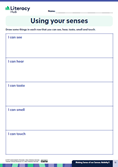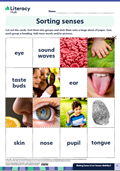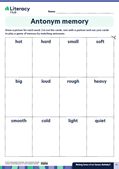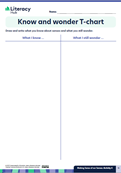Making Sense of our Senses
This informative text is an explanation that explores our five senses; how they work and how they help us to learn about the world around us.
Back to the shared reading overview page
Text download
Making Sense of our Senses as PDF (22.5MB) (opens in new window)
Making Sense of our Senses as PowerPoint slideshow (15.1MB) (download)
Printable worksheets
|
|
|
|
|

Teaching & learning sequence
This teaching and learning sequence outlines classroom strategies for Making Sense of our Senses, including:
- ways to incorporate the ‘Big Six’ core elements of reading development
- fun, engaging and adaptable student activities for a diverse range of abilities
- links to the Australian Curriculum.
| Text features | Cross-curriculum link to the Australian Curriculum |
|
|

First read
As a whole group, enjoy sharing the text and learning together.
Engage
Play a guessing game using a ‘feely bag’. Place a common classroom object such as a crayon into a cloth shopping bag without students seeing. Choose a student to feel inside the bag and guess what the object is. Encourage them to describe the object’s qualities before guessing. What does it feel like? Use their responses to create a list of adjectives (retain for later use).
Repeat by choosing other students to feel a range of different objects such as a piece of fruit, a spoon, a ruler, a small soft toy, a tennis ball, a wooden jigsaw puzzle piece or a lump of playdough.
Discuss as a group. How did you know what you were feeling inside the bag? Draw out that the sense of touch helps you to know what the object is. What other senses help us to know things? Discuss and draw out that we can touch, see, hear, smell and taste things.
Encourage students who speak a language other than English to say the names of the five senses in their home language.
Read aloud
Show the front cover of Making Sense of our Senses. Draw up a T-chart on a large chart with the headings ‘Know’ and ‘Wonder’. What do we already know about our senses? What things do you wonder about? Use students’ responses to scribe ideas onto the chart.
Read the text aloud. Take time to discuss the images and diagrams, and check for understanding of subject specific vocabulary. Discuss the facts in the ‘Wow!’ boxes, and encourage students to ask questions or make comments.
Make meaning
Revisit the ‘Know/Wonder’ T-chart. What new information do we now have about senses? Were our initial ideas correct? What information do we need to change? Change and/or add new information to the T-chart, and add further wonderings to the second column.
Revisit the text
Return to the text several times to look more closely at different aspects of its content, structure and language features. This is a great vehicle for exploring the ‘Big Six’ of literacy in an integrated way, with all components linking to the same text.
Comprehension
Reading is about making meaning. Choose from these comprehension activities to help your students explore the text deeply, make personal connections, develop new understandings, and draw conclusions. The activities will also help students analyse the text, think critically about it and form their own opinions.
Diversity and inclusion
The text Making Sense of our Senses provides an opportunity to discuss diversity and inclusion with your class, particularly if there are members of your school community who have physical disabilities or challenges. You could:
- discuss the concept that people can have different levels of vision, hearing or sense of smell and taste
- talk about ways to include everyone in learning and social activities
- practise ways of positively interacting with others to include them in games.
Viewing visuals (whole-group activity)
Revisit the text to view the images and labelled diagrams closely. Draw students’ attention to the diagram of the eye on pages 6 and 7 of the text, and read the caption aloud. Discuss the purpose of a caption, and why it is needed. Discuss the labels and what the arrows mean. Why is a diagram a good way of showing how the eye works?
View the diagram of the ear on pages 12 and 13. Discuss the information it gives, the caption and the purpose of the diagram.
Discuss the close-up photograph of taste buds on pages 14 and 15, and read the caption aloud. Ask students to think about how the photograph may have been taken. Explain that some things can only be seen through a microscope that magnifies them.
View the visual summary on page 23. Why do you think the author has included this on the last page?
Discuss and draw out that it is a summary of the information. Do you think a visual summary is a better way to explain things than just using words? Why?
Australian Curriculum links
Talking text types (whole-group activity)
Discuss what sort of text Making Sense of our Senses is. What is the purpose of this book? Discuss and draw out that the purpose is to explain how our senses work and how they help us. Discuss that it is called an explanation, and that an explanation explains how or why something happens.
How do we know that this is an informative text, not an imaginary text? What features does it have that shows us that it is an informative text? Ask students to turn and talk with a partner about the features that the text has. Have students share their ideas about features (for example, labelled diagrams, images, captions, visual summary, facts).
Australian Curriculum links
Summarising senses (whole-group activity)
Invite a student to lie on their back on a large sheet of paper and use a felt tip pen to trace around their body. Have the student stand up and then add eyes, nose, hair, ears and a mouth to the outline.
Invite students to add to the large outline labels related to the senses, for example: sight, eyes; ears, hearing; smell, nose; taste, tongue; touch, fingers.
Add a title and display in the classroom.
Australian Curriculum links
What do you sense? (individual and small-group activity)
Discuss how helpful the senses are. What can you see/hear/smell/taste/touch? Why is it useful for you to do these things?
To give all students in your class meaningful activities that they can accomplish, provide them with the following alternatives.
Alternative 1
Ask students to draw objects in each row on the Using your senses printable worksheet to show examples of things they can see, hear, taste, smell and touch. Have students share their completed charts in small groups.
Print the Using your senses worksheet.
Alternative 2
Ask students to give examples of senses that they use and why these are important to their daily life. They can present these in a way that is comfortable and natural for them such as by drawing, writing or using modelling clay. Support students with English as an additional language or dialect (EAL/D) by giving them the opportunity to act out ways that their senses help them in their everyday lives.
Australian Curriculum links
Sorting senses (small-group activity)
Have students work in small groups to complete a sorting activity using the Sorting senses printable worksheet. Ask them to cut out the cards and sort them into groups.
Groups can stick the cards onto a large sheet of paper and add headings for each group (sight, hearing, taste, smell, touch). Have them add further words and pictures that relate to each sense.
Print the Sorting senses worksheet.
Australian Curriculum links
Thinking further (whole-group activity)
Pose the question: How do our senses help us? Discuss as a group. What things can people use if they need help to see or hear better? Discuss, drawing out that people who live with sight (vision) or hearing loss use a variety of things to help them – glasses and hearing aids, for example. Also discuss alternative ways of communicating, such as sign language (Auslan, for example) and Braille, or other methods used by someone in the class, or someone the students know.
Australian Curriculum links
Phonological awareness (including phonemic awareness)
These activities will help students to hear the sounds and rhythms of language. Guide them as they explore syllables, onset and rime and listen for phonemes – the smallest units of sound within a word. Use the activities to help your students identify the phonemes in words and practise blending, segmenting and manipulating these sounds.
Hearing initial sounds (whole-group activity)
Revisit pages 6 and 7, and pages 8 and 9 of the text. Explain to students that you want them to listen as you read for words that begin with the s sound. After reading, talk about all of the words on this page that begin with this sound (sight, see, small, circles, signals, sent, seeing, so).
Repeat with the text on pages 14 and 15 and ask students to listen for words that begin with the t sound (taste, tongue, tiny, tastebuds, touches, to).
Australian Curriculum links
Rhyming words (whole-group activity)
Revisit pages 6 and 7. Explain that these pages are about ‘sight’. What sounds can you hear in the word ‘sight’? Have students say the word ‘sight’ to a partner. Discuss as a group and draw out that the sounds in the word ‘sight’ are – s, long i and t.
Repeat with the word ‘light’ – l, long i and t.
As a group, talk about the similar sounds in the words ‘sight’ and ‘light’. Discuss and draw out that they have the same middle and end sounds and this means they rhyme. Ask students to think of other words that rhyme with ‘sight’ and ‘light’ (for example, right, kite, might, fight, height, bite, fright, night).
Revisit pages 10 and 11 and focus on the words ‘hear’ and ‘ear’. As a group, talk about words that rhyme with these words (cheer, fear, clear, tear, dear, peer, gear, rear, weir).
Australian Curriculum links
Phonics
Evidence shows that children learn best about the relationship between phonemes and graphemes when instruction occurs through a daily structured synthetic phonics program (also known as systematic synthetic phonics). Knowing about these relationships will help students to decode, and this is crucial for their continued reading development.
In addition to your phonics program it is helpful to expose students to letter–sound relationships they come across in other contexts, such as during shared reading experiences. Choose activities that are relevant to your students so they can practise and reinforce already learnt concepts, so as to build automaticity in recognising letter–sound relationships.
Blending (whole-group activity)
Write the word ‘see’ on a chart. Invite a student to say the sounds they hear in the word – s and long e. Model how to blend the sounds together from left to right to decode the word.
As a group explore the blending of CVC (consonant, vowel, consonant) words from the text ‘bud’ and ‘hot’.
Repeat with other topic words in the text (for example, nose, taste, hand, sniff, brain, smell, sense, skin, blink, hand, safe). Choose words that include phonics your students have already learnt, so they can practise using this knowledge to decode.
Australian Curriculum links
Unusual spellings (whole-group activity)
Use topic words from the text to practise decoding uncommon letter–sound correspondences that your students have learnt (for example, long i – ‘eye’; t, u, ch – ‘touch’; t, u, ng – ‘tongue’). Write each word on a chart and discuss the letters that represent each sound in the word.
Australian Curriculum links
Oral language
Oral language development begins at birth, and having a rich oral language is beneficial as a foundational and ongoing resource for literacy development. Oral language is embedded throughout the shared reading experience as students listen and respond to quality texts.
It is also valuable to involve students in specific activities that will continue to improve their oral language skills. Choose from these activities to help students develop and practise important communication skills.
Hearing not seeing (whole-group activity)
Highlight the sense of sound by playing these simple games.
What can you hear?
Invite a student to wear a blindfold. Have another student make a noise such as clapping, clicking fingers, stamping feet or using an instrument such as a shaker, tapping sticks, a triangle, drum or tambourine. The blindfolded student listens and then describes the sound they hear (for example, low, soft, high, loud). They then guess what made the sound.
Alternatively, use apps or ringtones on a phone to make various sounds for the students to guess.
Where do I go?
Have one student blindfolded and another student giving directions. The student giving directions explains to the blindfolded student how to get to a certain place in the classroom. Encourage the student giving directions to speak clearly using an appropriate volume. (Note: First clear the space of anything that the blindfolded student may trip over or run into.)
Discuss
Talk about how the sense of hearing can help us. How can sound help to keep us safe? What examples can you think of? (Some examples: traffic light sounds telling us when to cross, sirens on emergency vehicles, bells at railway crossings, smoke alarms, car horns, bike bells.)
Australian Curriculum links
Seeing not hearing (whole-group activity)
Highlight ways that people can communicate without using words by playing these simple games.
Act it out
Play a game of charades by asking a student to act out a simple scenario such as taking the dog for a walk, shooting a basketball, cooking a cake, swimming at the beach, reading a funny book or playing the piano. The other students try to guess what the student is doing.
Feeling faces
Write the names of feelings onto cards (for example, happy, sad, disappointed, surprised, angry, shocked). Choose a student to pick a card and show the feeling using facial gestures. The other students try to guess what the feeling is.
Discuss
Talk with the students about the ‘Seeing not hearing’ games, and what they have learnt. How did we communicate what we were doing or feeling? Do we always need to hear words to find out about things? Encourage students to share their ideas.
Australian Curriculum links
Talking senses (individual activity)
Have students choose one sense to write or draw about. Invite students to share their writing/drawing one at a time in a small group. Encourage students to speak clearly and make eye contact with the audience when they are presenting their understandings.
Australian Curriculum links
Fluency
Activities aimed at teaching and practising fluency are important for students on their journey towards becoming independent readers. Explicitly modelling fluency and providing opportunities for students to practise reading aloud are integral to this.
Activities aimed at teaching and practising fluency are important for students on their journey towards becoming independent readers. Explicitly modelling fluency and providing opportunities for students to practise reading aloud are integral to this.
Echo reading (whole-group activity)
- Revisit the text, explicitly point out that you are going to read the first sentence smoothly, using phrasing to model fluency, and ask the students to listen carefully for this.
- Model reading the sentence aloud fluently.
- Ask students to repeat the sentence, copying your voice like an echo.
- Continue ‘echo reading’ more of the text as appropriate.
Australian Curriculum links
Vocabulary
Having a rich, broad vocabulary assists students when they are tackling new texts. These vocabulary activities will help them to build their growing bank of words.
The activities introduce students to new Tier 2 and Tier 3 words, as well as exploring word families and a range of different word types.
Adding suffixes (whole-group activity)
Write the word ‘see’ on a chart and read it to the group. Now add the ‘-ing’ suffix to the word, and invite a student to read the word. How does adding this word part change the word? Discuss.
Repeat with other words from the text (hear/hearing, taste/tasting, smell/smelling, touch/touching).
Australian Curriculum links
Homophone hunt (whole-group activity)
Revisit the first sentence on page 6: We use our eyes to see. Talk about the meaning of the word ‘see’. What does ‘see’ mean? Can this word have another meaning? Discuss and draw out the spelling and meaning of the word ‘sea’. Explain that the words ‘see’ and ‘sea’ are homophones, and this means they sound the same, but they are spelt differently and have a different meaning. Write ‘see’ and ‘sea’ on a chart.
Repeat this activity with the words ‘sight’ and ‘site’ and ‘hear’ and ‘here’. Add these to the homophone chart. Have students think of other homophones to add the chart such as to/too/two, deer/dear, be/bee, for/four, scent/cent, flour/flower, hair/hare, know/no and not/knot.
Australian Curriculum links
- Year 2: AC9E2LA09
Word webs (small-group activity)
On a large chart, model how to create a semantic word web about senses, for example:
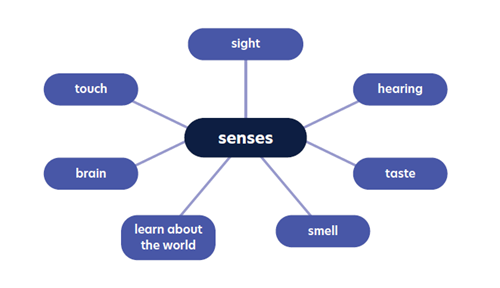
Split the class into five groups, with each responsible for one sense: sight, hearing, taste, smell, touch. Have each group create a semantic word web on a large chart about the sense they are responsible for.
Provide each group with printed pages from the text relevant to the sense they are presenting.
Encourage students to write and/or draw and to include technical words related to the topic – such as ‘pupil’, ‘signals’, ‘taste buds’, ‘sensors’ and ‘sound waves’.
Have each group present their word webs to the class.
Australian Curriculum links
Adjectives and antonyms (whole-group activity)
Revisit and read through the list of adjectives created during the Engage stage of ‘First read’.
Turn to pages 18 and 19 of the text. Tell students that you want them to listen for adjectives as you read these pages aloud. After reading ask: Did you hear describing words that are not on our list? (Some examples are: hot, cold, sharp, rough, smooth, soft, hard.) Add these words. What other adjectives can you think of? Continue to add further adjectives to the list.
Use the words on the list to introduce and discuss antonyms (a word with an opposite meaning to another word). Invite students to identify opposites (for example, hot/cold, soft/hard).
Optional activity 1 (partner activity)
Introduce the Antonym memory worksheet. Have students work with a partner to cut out the cards, and draw a picture on each card to represent the words. Pairs use their cards to play a game of memory by matching the antonyms – opposites.
Print the Antonym memory worksheet.
Optional activity 2 (partner activity)
Have students work with a partner to think of a set of antonyms such as up and down, hot and cold, or rough and smooth. Have the pairs draw a picture that shows the meaning of these antonyms. Have each pair share their drawings with the class.
Australian Curriculum links
- Year 2: AC9E2LA09
Tenses of senses (whole-group activity)
Hold up a common classroom item such as a book. What can you see? Ask a student to say their answer in a full sentence: ‘I can see a book.’ Write the sentence on a chart, and circle the word ‘see’.
Prompt the student to think about speaking in the past tense. What would you say if you saw this book yesterday? ‘I saw the book yesterday.’
Write this sentence on a chart, and circle the word ‘saw’. Talk about the words ‘see’ and ‘saw’, and talk about why we use different words when we are talking about when things happen.
Write sentences highlighting past and present tense related to the other senses:
- I hear the bell. I heard the bell.
- I touch the soft toy. I touched the soft toy.
- I smell the smoke. I smelt the smoke.
Australian Curriculum links
Reflecting on learning
Help students ‘bring it all together’ and reflect on their understandings by completing the graphic organiser either independently or with a partner.
Know and wonder T-chart
Have students turn and talk with a partner about the things they now know about their senses. Then discuss as a class: What things would you still like to find out about your senses?
Have students complete the T-chart by writing and/or drawing what they know about senses and what they still wonder.
Print the Know and wonder T-chart worksheet.
For families - new for 2024!Reinforce your classroom learning by telling families in your class about Making Sense of our Senses. Families can share the text at home and use the information provided to build knowledge and instill a love of reading. Find out more about Making Sense of our Senses (for families) |
